Wishing everyone happy holidays and a joyful New Year from the Healthify team. Don't forget to Slip, Slop, Slap and Wrap!
Raynaud's syndrome
Also known as Raynaud's phenomenon
Key points about Raynaud's syndrome
- Raynaud's (pronounced 'ray-nohz') syndrome is when your fingers or toes (matimati) go numb and turn white or blue in colour when you're cold.
- Raynaud's is uncomfortable, but usually harmless. There are practical things you can do to prevent attacks.
- These include trying to keep your body at a constant temperature, reducing stress, looking after your skin and protecting your hands from cold and damage.

- Some or all of your fingers and toes (matimati) turn white or blue and become numb when exposed to cold or sudden temperature change.
- When warmed again, they go bright red.
- You may also have pain or pins and needles, or have difficulty moving your fingers or toes.
- Attacks can last minutes or hours.

Image credit: Canva
Why does this happen?
The colour change is due to changes in blood circulation with narrowing in the small blood vessels in the skin of your hands and feet. This may also occur in other areas such as your nose, earlobes and occasionally your tongue or nipples.
The cause of Raynaud's is unknown but it can sometimes run in families. The use of chainsaws, jack-hammers or similar vibrating equipment may bring on a Raynaud's attack. For some people, medicines such as beta-blockers, migraine treatments and chemotherapy drugs can bring on Raynaud's.
In a small number of people, Raynaud's may be the first indication that an underlying condition, such as an autoimmune disorder, may be present. An example is the connective tissue disease called scleroderma. A simple blood test can be done that looks for special markers or antibodies in your blood that show whether or not you may have this condition. If the test is positive, your doctor will carry out further tests.
There is no cure, but there are practical things you can do to prevent attacks (see below).
When you have an attack, stay calm and gently re-warm your fingers or toes as soon as you can. Placing your hands under your armpits or swinging your arms during an attack often helps. Go inside if you are outdoors, as this is usually warmer. Try wiggling your fingers or toes. Move or walk around to try and improve your circulation. If you can, run warm (not hot) water over the affected part of your body until normal colour returns.
If your symptoms are severe or cause a lot of problems, your doctor may be able to prescribe medication to help improve blood flow. Calcium channel blockers, eg, nifedipine or diltiazem, work by dilating the small blood vessels. Your doctor will advise you on whether this sort of medication is suitable for you.
Aim for constant temperature
- Try to keep your body temperature constant by wearing several layers of clothes.
- Wear warm gloves/mittens and thick socks.
- Try to avoid sudden changes in temperature.
- Don't sit in draughts and be aware of air conditioning as this can make rooms very cool.
- Always wear a hat – you lose a lot of heat through the top of your head.
- Try to avoid sweating too much or make sure you use clothes that wick sweat away from your body, because sweat cools your body.
Exercise and reduce stress
- Exercise is excellent for keeping warm (and for general health), but is not effective if you are experiencing an attack.
- Stress can trigger an attack. Explore ways to manage stress such as breathing exercises, mindfulness or yoga.
- Don't smoke – smoking constricts your blood vessels, making it harder for the blood to flow.
Skincare
- Use skin cream to keep your skin supple and soft.
- Keep the affected skin dry – as water on your skin evaporates, it cools the skin which makes the circulatory changes worse.
- Keep your fingernails and hands clean at all times.
Household tips
- Protect your hands with suitable gloves when gardening or doing jobs around the house.
- Don't get things from the freezer without using insulated gloves or mittens.
- Don't handle cold items such as milk bottles straight from the fridge as this can bring on a spasm in the fingers.
- If you're going on a trip and it's likely to be cold, take a hot water bottle or 'Heat Wheat' mitts which can be warmed in the microwave.
- Don't carry heavy shopping bags with handles because this can restrict the blood flow to your fingers – use shoulder bags where possible.
- Avoid your hands being in contact with cold water for too long, eg, don't peel vegetables under a running tap, hose the garden if the hose nozzle leaks or hand wet clothes on a clothesline.
- Start running your bath or shower water ahead of time so that you don't touch cold water. Be careful not to get chilled getting in and out of the tub or shower.
- If possible, have someone start your car and turn on the heater a few minutes before you leave the house.
- If you have your first attack of Raynaud’s when you’re over 25.
- If your child has Raynaud’s symptoms and is younger than 12.
- If your symptoms are severe or interfere greatly with your quality of life/hauora.
- If you notice small ulcers at the tips of your fingers.
- If you have chilblains/māngiongio or cracked skin around your nails/maikuku as well as symptoms of Raynaud’s.
Raynaud phenomenon(external link) DermNet NZ
Raynaud's(external link) NHS, UK
References
- Raynaud phenomenon(external link) DermNet NZ, 2022
- Raynaud's(external link) NHS, UK, 2020
Credits: Healthify editorial team. Healthify is brought to you by Health Navigator Charitable Trust.
Last reviewed:
Page last updated:





